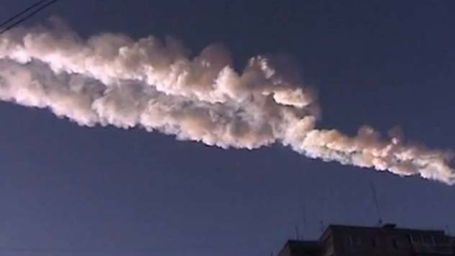
It's really starting to look like the sky is falling.
According to media reports, a fireball streaked through the skies above California's Bay Area Friday evening (Feb. 15), just hours after another bright meteor exploded over the Russian city of Chelyabinsk and a 150-foot-wide (45 meters) asteroid gave Earth a historically close shave.
The Bay Area fireball blazed up around 7:45 p.m. local time Friday (10:45 p.m. EST; 0345 GMT Saturday), NBC Bay Area reported. The meteor apparently had a bluish tinge and was visible over a wide swath of the region, from Fairfield north of San Francisco Bay down to Gilroy, which is south of San Jose.
There were no immediate reports of injuries, which distinguished the California fireball from its Russian counterpart. The Chelyabinsk blast generated a powerful shock wave that damaged hundreds of buildings and wounded more than 1,000 people.
Friday's Russian fireball was the largest such explosion since a 1908 airburst levelled 825 square miles (2,137 square kilometers) of forest in the Tunguska region of Siberia, NASA scientists said.
The flyby of asteroid 2012 DA14, which also took place Friday, didn't generate such pyrotechnics in the atmosphere, but it was dramatic enough in its own right. The space rock cruised to within 17,200 miles (27,000 km) of Earth at one point, coming closer than the ring of geosynchronous satellites circling the planet.
The flyby marked the closest approach of such a large asteroid that astronomers had ever known about in advance.
Get the Space.com Newsletter
Breaking space news, the latest updates on rocket launches, skywatching events and more!
The space rock that generated the Chelyabinsk fireball had nothing to do with asteroid 2012 DA14, NASA researchers stressed. Little is known about where the Bay Area meteor came from at the moment, but it may turn out to be unrelated as well, making Friday a day of truly improbable cosmic coincidences.
Follow SPACE.com senior writer Mike Wall on Twitter @michaeldwall or SPACE.com @Spacedotcom. We're also on Facebook and Google+.
Join our Space Forums to keep talking space on the latest missions, night sky and more! And if you have a news tip, correction or comment, let us know at: community@space.com.

Michael Wall is a Senior Space Writer with Space.com and joined the team in 2010. He primarily covers exoplanets, spaceflight and military space, but has been known to dabble in the space art beat. His book about the search for alien life, "Out There," was published on Nov. 13, 2018. Before becoming a science writer, Michael worked as a herpetologist and wildlife biologist. He has a Ph.D. in evolutionary biology from the University of Sydney, Australia, a bachelor's degree from the University of Arizona, and a graduate certificate in science writing from the University of California, Santa Cruz. To find out what his latest project is, you can follow Michael on Twitter.
